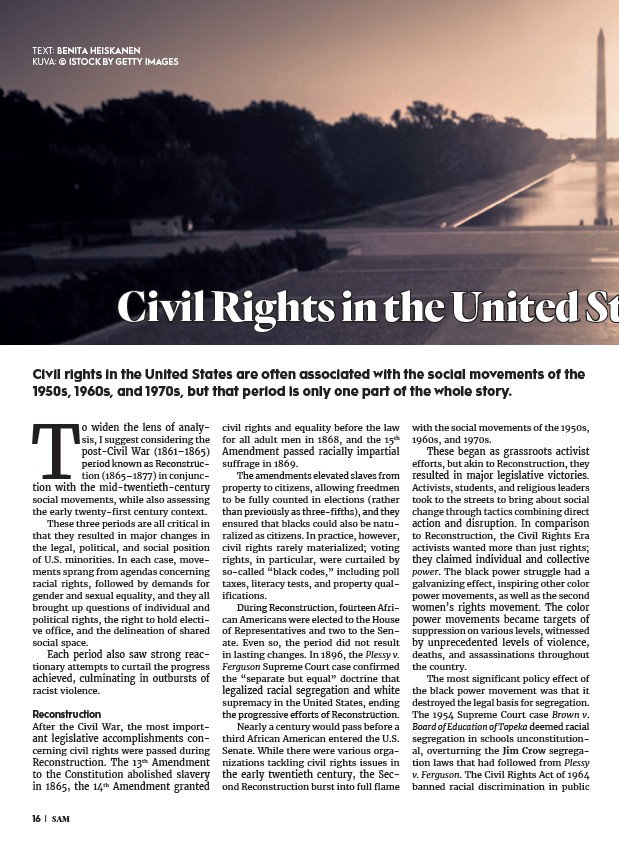
Civil Rights in the United States:TEXT:To widen the lens of analy-sis,
I suggest considering the
post-Civil War (1861–1865)
period known as Reconstruc-tion
(1865–1877) in conjunc-tion
with the mid-twentieth-century
social movements, while also assessing
the early twenty-first century context.
These three periods are all critical in
that they resulted in major changes in
the legal, political, and social position
of U.S. minorities. In each case, move-ments
sprang from agendas concerning
racial rights, followed by demands for
gender and sexual equality, and they all
brought up questions of individual and
political rights, the right to hold electi-ve
office, and the delineation of shared
social space.
Each period also saw strong reac-tionary
attempts to curtail the progress
achieved, culminating in outbursts of
racist violence.
Reconstruction
After the Civil War, the most import-ant
legislative accomplishments con-cerning
civil rights were passed during
Reconstruction. The 13th Amendment
to the Constitution abolished slavery
in 1865, the 14th Amendment granted
civil rights and equality before the law
for all adult men in 1868, and the 15th
Amendment passed racially impartial
suffrage in 1869.
The amendments elevated slaves from
property to citizens, allowing freedmen
to be fully counted in elections (rather
than previously as three-fifths), and they
ensured that blacks could also be natu-ralized
as citizens. In practice, however,
civil rights rarely materialized; voting
rights, in particular, were curtailed by
so-called “black codes,” including poll
taxes, literacy tests, and property qual-ifications.
During Reconstruction, fourteen Afri-can
Americans were elected to the House
of Representatives and two to the Sen-ate.
Even so, the period did not result
in lasting changes. In 1896, the Plessy v.
Ferguson Supreme Court case confirmed
the “separate but equal” doctrine that
legalized racial segregation and white
supremacy in the United States, ending
the progressive efforts of Reconstruction.
Nearly a century would pass before a
third African American entered the U.S.
Senate. While there were various orga-nizations
tackling civil rights issues in
the early twentieth century, the Sec-ond
Reconstruction burst into full flame
with the social movements of the 1950s,
1960s, and 1970s.
These began as grassroots activist
efforts, but akin to Reconstruction, they
resulted in major legislative victories.
Activists, students, and religious leaders
took to the streets to bring about social
change through tactics combining direct
action and disruption. In comparison
to Reconstruction, the Civil Rights Era
activists wanted more than just rights;
they claimed individual and collective
power. The black power struggle had a
galvanizing effect, inspiring other color
power movements, as well as the second
women’s rights movement. The color
power movements became targets of
suppression on various levels, witnessed
by unprecedented levels of violence,
deaths, and assassinations throughout
the country.
The most significant policy effect of
the black power movement was that it
destroyed the legal basis for segregation.
The 1954 Supreme Court case Brown v.
Board of Education of Topeka deemed racial
segregation in schools unconstitution-al,
overturning the Jim Crow segrega-tion
laws that had followed from Plessy
v. Ferguson. The Civil Rights Act of 1964
banned racial discrimination in public
BENITA HEISKANEN
KUVA: © ISTOCK BY GETTY IMAGES
Civil rights in the United States are often associated with the social movements of the
1950s, 1960s, and 1970s, but that period is only one part of the whole story.
16 | SAM